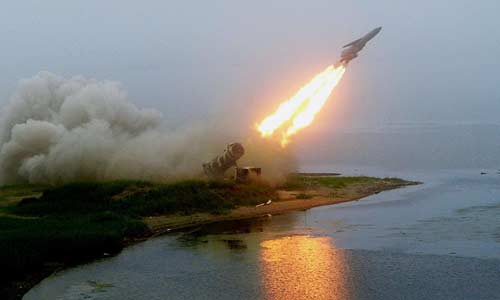Brahmos-II and the unstoppable Zircon Missile will have the same Scramjet Engine
Russia is expected to begin serial production of hypersonic missile Tsirkon or Zircon soon. The missile boasts of speed five times than that of speed of sound. Reports say the missile can travel with a speed of upto 4,600 mph or 7,400 km/h, which makes it almost impossible to be stopped.
Countries like the US and Britain, who have most powerful defence forces in the world, are already losing sweat over Russia's new missile defence system.
"State tests of Zircon are scheduled for completion in 2017 in accordance with the contract, and the missile's serial production is planned to be launched next year," a report carried out by Russian news agency TASS said quoting sources.
US, BRITAIN WORRIED
Zircon, which can strike targets as far as 400 km away, is expected to be inducted by the Russia defence forces by 2022. With its enormous speed, Zircon is capable of evading the best anti-missile systems presently in use across the world. A report in The Independent said that UK's Royal Navy's new aircraft carriers would be unable to stop.
The Royal Navy's current Sea Ceptor missile system can only shoot down missiles travelling up to 2,300mph, the report said.
On the other hand, the US Navy is worried that Russia may fit Zircon to its nuclear-powered Kirkov warship.
WHAT MAKES ZIRCON LETHAL
Zircon works on the scramjet technology to attain its hypersonic speeds. The missile uses air pressure for propulsion. A specially designed system pushes air from the atmosphere into the combustion chamber where the air is mixed with the on-board fuel to provide energy.
What makes Zircon lightweight and faster than other missiles is that it doesn't carry oxidizer. There are no fans or turbines to propel it, which essentially means less chances of any mechanical failure.
WHEN WILL INDIA HAVE ITS OWN HYPERSONIC MISSILE
Russia may have taken the lead in developing a hypersonic missile, but India is not far behind. India is developing a second generation BrahMos-II missile is collaboration with Russia. The missile will use the same scramjet technology that Zircon has.
The BrahMos-II is expected to have a range of 600 km. The missile is expected to be ready for testing by 2020.
Countries like the US and Britain, who have most powerful defence forces in the world, are already losing sweat over Russia's new missile defence system.
"State tests of Zircon are scheduled for completion in 2017 in accordance with the contract, and the missile's serial production is planned to be launched next year," a report carried out by Russian news agency TASS said quoting sources.
US, BRITAIN WORRIED
Zircon, which can strike targets as far as 400 km away, is expected to be inducted by the Russia defence forces by 2022. With its enormous speed, Zircon is capable of evading the best anti-missile systems presently in use across the world. A report in The Independent said that UK's Royal Navy's new aircraft carriers would be unable to stop.
The Royal Navy's current Sea Ceptor missile system can only shoot down missiles travelling up to 2,300mph, the report said.
On the other hand, the US Navy is worried that Russia may fit Zircon to its nuclear-powered Kirkov warship.
WHAT MAKES ZIRCON LETHAL
Zircon works on the scramjet technology to attain its hypersonic speeds. The missile uses air pressure for propulsion. A specially designed system pushes air from the atmosphere into the combustion chamber where the air is mixed with the on-board fuel to provide energy.
What makes Zircon lightweight and faster than other missiles is that it doesn't carry oxidizer. There are no fans or turbines to propel it, which essentially means less chances of any mechanical failure.
WHEN WILL INDIA HAVE ITS OWN HYPERSONIC MISSILE
Russia may have taken the lead in developing a hypersonic missile, but India is not far behind. India is developing a second generation BrahMos-II missile is collaboration with Russia. The missile will use the same scramjet technology that Zircon has.
The BrahMos-II is expected to have a range of 600 km. The missile is expected to be ready for testing by 2020.

Comments
Post a Comment